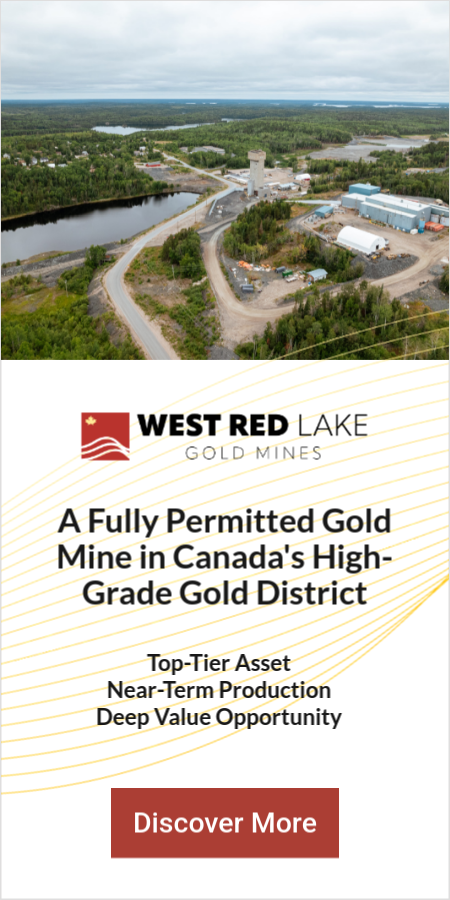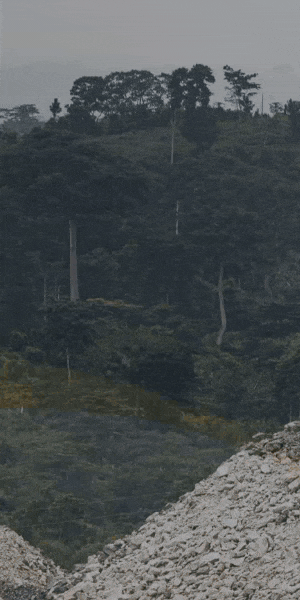With Updated PEA in Progress and EIA Applied, Omai Accelerates 6.5 Moz Project Buildout
%20(1).png)
Omai expanded to 6.5M oz, proving depth continuation 700m down. Targeting 12-15ktpd integrated operation. $40M funded, permits advancing. One of largest undeveloped gold projects.
- Omai Gold Mines expanded its mineral resource from 4.3 million to 6.5 million ounces in August 2025, making it one of the largest undeveloped gold projects globally
- The company pivoted strategy in early 2025 after discovering exceptionally wide, high-grade intercepts at depth (4.5 g/t over 57 meters), focusing drilling on expanding these zones
- New integrated PEA in development will combine the Wenot open pit deposit (averaging 1.5+ g/t) with nearby Gilt Creek underground mine, targeting 12,000-15,000 tonnes per day processing capacity, targeted for early 2026
- Deep drilling 700 meters below known mineralization successfully intersected the shear structure with seven distinct gold zones, proving continuation at depth
- Company completed $40 million financing at four times earlier pricing with less than 5% dilution and received environmental permit; community consultation meetings scheduled
Omai Gold Mines has achieved significant milestones in 2025, dramatically expanding its flagship project in Guyana from 4.3 million ounces to 6.5 million ounces through an aggressive drilling campaign. CEO Elaine Ellingham, outlined how the company pivoted its exploration strategy after discovering exceptionally wide, high-grade intercepts in early 2025, ultimately delivering one of the year's most substantial resource increases in the junior gold sector. With a robust balance sheet following a $40 million financing, advanced permitting progress, and ongoing drilling across five rigs, the company is positioning itself to develop one of the largest undeveloped gold projects globally.
Strategic Pivot: From Incremental Growth to Aggressive Expansion
The company's trajectory changed dramatically in early January 2025 when assay results revealed intercepts including 4.5 grams per tonne over 57 meters and 3.2 grams per tonne over 68 meters at the Wenot deposit. As Ellingham explained,
"I would say these are the widest, best intercepts ever for Wenot. So we decided, we should be pursuing these zones because when you're seeing things like that you can add the ounces quickly."
This decision represented a departure from the company's 2024 preliminary economic assessment (PEA), which had been based on approximately 43% of resources and contemplated a 9,000 tonne per day operation focused solely on the open-pittable Wenot deposit. The company deployed three drill rigs initially, expanding to four in April, concentrating efforts on defining the extent of the deeper, wider mineralized zones that had emerged from late 2024 drilling.
The strategic shift proved successful when the updated 43-101 mineral resource was published in August 2025, revealing the 2.2 million ounce increase. Ellingham noted,
"We even surprised ourselves, we were delighted and it really does put it in the category of one of the largest undeveloped gold projects."
Deposit Characteristics
The Wenot deposit represents a 2.5-kilometer-long shear-hosted system with open-pittable mineralization averaging over 1.5 grams per tonne, a grade Ellingham characterized as "quite impressive" for an open pit environment. The deposit's geometry and grade profile support the company's plans for a starter pit at Wenot West, which comes to surface and was never historically mined, before expanding into the main Wenot zone.
Located just 450 meters from Wenot, the Gilt Creek deposit adds underground mining potential to the project. The proximity enables integrated mine planning, with ore from both deposits feeding a single processing facility.
The staggered underground development reflects practical considerations around final drilling, which becomes more efficient once decline access enables drilling from underground positions rather than from surface. As Ellingham noted,
"A lot of the final drilling you have to do is done once you've got your decline and you're actually drilling from underground because drilling from surface is very inefficient, not very cost effective."
Deep Drilling Success: Proof of Concept at Depth
One of 2025's most significant technical achievements came from an exceptionally deep drill hole that started in the Gilt Creek deposit and continued beneath Wenot, ultimately drilling 700 meters below the lowest previously identified mineralization. The hole successfully intersected approximately 260 meters of the shear structure and encountered seven distinct gold zones across different lithologies.
"We felt like if it's there, we can't miss it. And we didn't. So we drilled through about 260 meters of the shear and we figured that was a win, but we also hit seven gold zones. So it was a big win."
The intercept proves the shear structure continues to depth and remains mineralized, opening the potential for significantly expanding the resource. If the 2.5-kilometer strike length observed at surface extends to these depths, Ellingham suggested "you could have the potential to even double the size of that deposit."
The drilling revealed multiple mineralization styles across the shear zone, including mineralization hosted in rhyolite dikes, quartz-feldspar porphyry, and quartz veins within sediments. This geological complexity, while requiring careful analysis of individual zones and potential plunging ore shoots, also provided confidence during the initial deep drilling.
Notably, one of the final intercepts before the hole ended returned grades of 5.5 and 7.5 grams per tonne just five meters from the bottom of the hole. The hole had to be terminated at an 11-degree angle to avoid losing equipment, leaving the possibility of additional mineralization beyond what was intersected.
Interview with Elaine Ellingham, CEO of Omai Gold Mines
Updated PEA
The company is advancing toward an updated PEA that will integrate both the expanded Wenot open pit and the Gilt Creek underground mine into a single operation contemplating 12,000 to 15,000 tonnes per day throughput, a substantial increase from the previous 9,000 tonne per day concept. This scale reflects both the resource growth and the favourable gold price environment.
"Regardless of the gold price, this project can handle a much lower gold price. It just ends up being extremely robust economically in this environment."
The company is accelerating work typically reserved for prefeasibility studies, including metallurgical testing on zones that differ from historical processing, detailed tailings facility engineering, and biodiversity and water studies. Particularly significant is the work on the existing tailings facility, which historical operations left with excess capacity.
Additionally, the historical Gilt Creek pit offers further tailings capacity, reducing capital requirements and environmental footprint compared to greenfield developments.
Satellite Targets for Expansion
Beyond Wenot and Gilt Creek, the company is evaluating several satellite targets that could provide additional feed and improve project economics. Recent drilling at a target, located near the main deposits, intersected 20.3 grams per tonne over 5.3 meters at just 50 meters depth. The target shows gold mineralization in trenches along a 500-meter trend with a different geological character - ladder veins with flat-lying structures visible in outcrop.
The Camp zone, approximately half a kilometer from Wenot, returned 2.7 grams per tonne over 12 meters within 50 meters of surface in fresh rock. Both targets represent potential satellite pits that could provide higher-grade feed during operations.
"These are perfect satellite pits," Ellingham observed, noting their proximity to the main deposits and shallow mineralization that would enable low-cost extraction.
The company is conducting systematic drilling campaigns on these targets - typically five to six holes per target, followed by assay review before designing subsequent drilling. This disciplined approach balances resource definition with capital efficiency.
Permitting Progress and Government Support
Omai received its environmental permit in November 2024 based on the previous PEA, and has since filed for an Environmental Impact Assessment (EIA) reflecting the expanded project scope. Community consultation meetings are scheduled within two weeks of the interview, representing a critical milestone in the permitting process.
The permitting timeline has benefited from the project footprint remaining substantially similar despite the larger scale - the expanded pit and underground portal location maintain the same basic footprint as previously permitted. "From an environmental perspective that's the way they look at it," Ellingham explained.
Political developments have also created a favourable environment for project advancement. The September 2025 presidential election resulted in a decisive victory for the incumbent government, with President Irfaan Ali securing 55-57% of the vote and gaining additional parliamentary seats. This outcome provides a five-year runway of policy stability.
"Their enthusiasm for Omai and the other large scale gold mine developments is very strong," Ellingham reported following meetings with government officials. The government's focus on developing the interior through large-scale mining projects complements its offshore oil and gas wealth, creating what Ellingham characterized as strong governmental support for the sector.
Financial Position and Operational Intensity
Approximately one month after publishing the August resource update, Omai completed a $40 million financing - "four times the price we did our previous financing early in the year," according to Ellingham, with less than 5% dilution. This financing provides a runway through multiple upcoming milestones and positions the company to maintain its aggressive exploration pace regardless of near-term market volatility.
Currently, five drill rigs are operating on the property, focusing on infill drilling to convert inferred resources to measured and indicated categories, drilling along the southern margin of Wenot to improve strip ratios and expand resources, and testing satellite targets. The intensity of operations reflects the company's sprint toward the updated PEA while continuing to expand the resource base.
"With five drills turning, we should have a lot of results coming out between here and January," Ellingham noted, indicating substantial news flow expected in the near term as the laboratory works through a backlog of samples.
The current drilling campaign targets the 2.5-kilometer Wenot strike length, which Ellingham characterized as "a lot of real estate" requiring systematic coverage. Much of the deposit remains at inferred category, representing an opportunity to increase confidence levels without necessarily discovering new mineralization.
TL;DR: Executive Summary
Omai Gold Mines has transformed its flagship Guyanese project in 2025, expanding resources from 4.3 to 6.5 million ounces through aggressive drilling after discovering exceptionally wide, high-grade zones. The company is advancing an integrated PEA targeting 12,000-15,000 tpd throughput combining the Wenot open pit (1.5+ g/t average) with the nearby Gilt Creek underground mine, leveraging existing infrastructure from historical operations. Deep drilling 700 meters below known mineralization successfully proved the shear system continues at depth with multiple gold zones, potentially enabling further resource expansion. With $40 million in recent financing, five operating drill rigs, advancing permitting, and strong government support, the company is positioned to develop one of the world's largest undeveloped gold projects in a favourable commodity price environment.
FAQs (AI Generated)
Analyst's Notes




Subscribe to Our Channel
Stay Informed



































